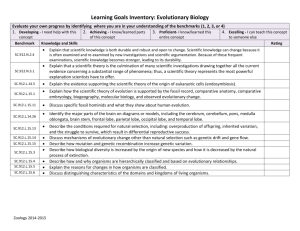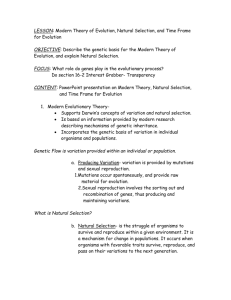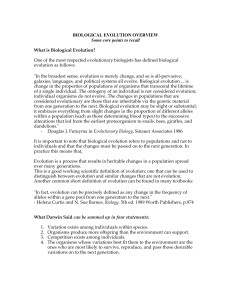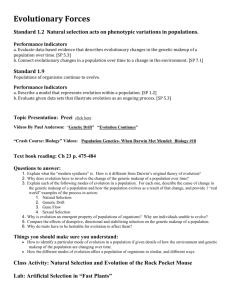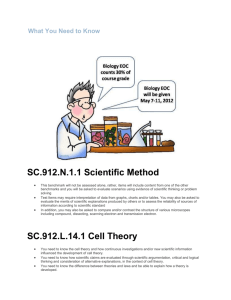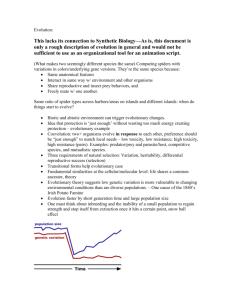WEEK 6 EOC Review Evolution, Human Body, Biotechnology
advertisement
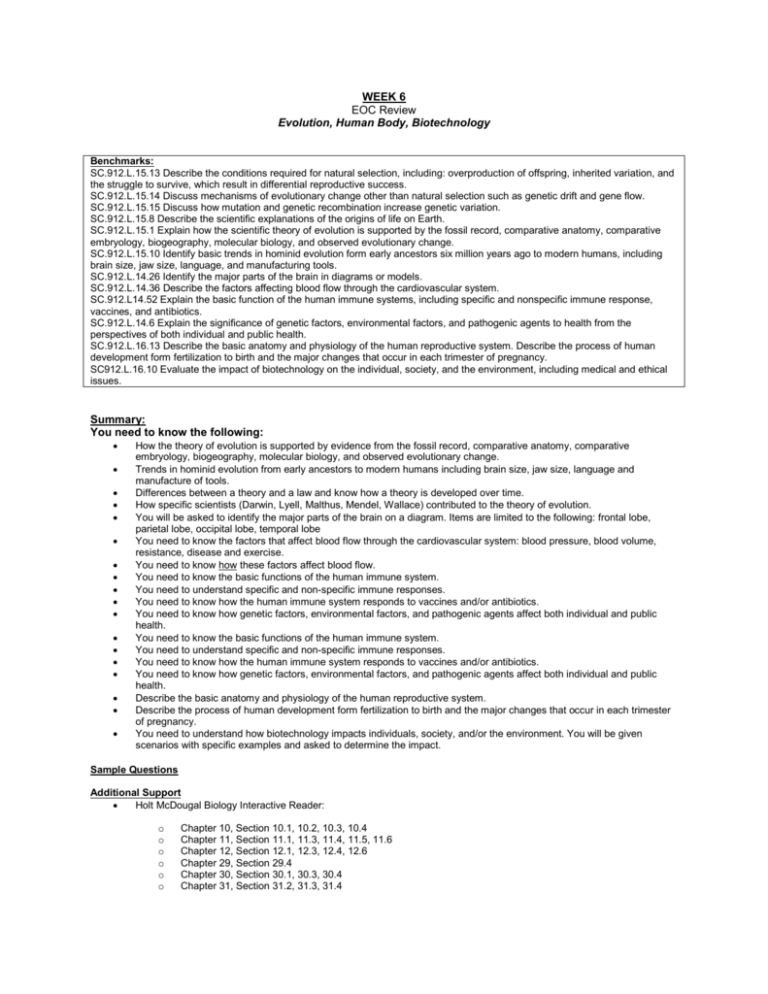
WEEK 6 EOC Review Evolution, Human Body, Biotechnology Benchmarks: SC.912.L.15.13 Describe the conditions required for natural selection, including: overproduction of offspring, inherited variation, and the struggle to survive, which result in differential reproductive success. SC.912.L.15.14 Discuss mechanisms of evolutionary change other than natural selection such as genetic drift and gene flow. SC.912.L.15.15 Discuss how mutation and genetic recombination increase genetic variation. SC.912.L.15.8 Describe the scientific explanations of the origins of life on Earth. SC.912.L.15.1 Explain how the scientific theory of evolution is supported by the fossil record, comparative anatomy, comparative embryology, biogeography, molecular biology, and observed evolutionary change. SC.912.L.15.10 Identify basic trends in hominid evolution form early ancestors six million years ago to modern humans, including brain size, jaw size, language, and manufacturing tools. SC.912.L.14.26 Identify the major parts of the brain in diagrams or models. SC.912.L.14.36 Describe the factors affecting blood flow through the cardiovascular system. SC.912.L14.52 Explain the basic function of the human immune systems, including specific and nonspecific immune response, vaccines, and antibiotics. SC.912.L.14.6 Explain the significance of genetic factors, environmental factors, and pathogenic agents to health from the perspectives of both individual and public health. SC.912.L.16.13 Describe the basic anatomy and physiology of the human reproductive system. Describe the process of human development form fertilization to birth and the major changes that occur in each trimester of pregnancy. SC912.L.16.10 Evaluate the impact of biotechnology on the individual, society, and the environment, including medical and ethical issues. Summary: You need to know the following: • • • • • • • • • • • • • • • • • • How the theory of evolution is supported by evidence from the fossil record, comparative anatomy, comparative embryology, biogeography, molecular biology, and observed evolutionary change. Trends in hominid evolution from early ancestors to modern humans including brain size, jaw size, language and manufacture of tools. Differences between a theory and a law and know how a theory is developed over time. How specific scientists (Darwin, Lyell, Malthus, Mendel, Wallace) contributed to the theory of evolution. You will be asked to identify the major parts of the brain on a diagram. Items are limited to the following: frontal lobe, parietal lobe, occipital lobe, temporal lobe You need to know the factors that affect blood flow through the cardiovascular system: blood pressure, blood volume, resistance, disease and exercise. You need to know how these factors affect blood flow. You need to know the basic functions of the human immune system. You need to understand specific and non-specific immune responses. You need to know how the human immune system responds to vaccines and/or antibiotics. You need to know how genetic factors, environmental factors, and pathogenic agents affect both individual and public health. You need to know the basic functions of the human immune system. You need to understand specific and non-specific immune responses. You need to know how the human immune system responds to vaccines and/or antibiotics. You need to know how genetic factors, environmental factors, and pathogenic agents affect both individual and public health. Describe the basic anatomy and physiology of the human reproductive system. Describe the process of human development form fertilization to birth and the major changes that occur in each trimester of pregnancy. You need to understand how biotechnology impacts individuals, society, and/or the environment. You will be given scenarios with specific examples and asked to determine the impact. Sample Questions Additional Support • Holt McDougal Biology Interactive Reader: o o o o o o Chapter 10, Section 10.1, 10.2, 10.3, 10.4 Chapter 11, Section 11.1, 11.3, 11.4, 11.5, 11.6 Chapter 12, Section 12.1, 12.3, 12.4, 12.6 Chapter 29, Section 29.4 Chapter 30, Section 30.1, 30.3, 30.4 Chapter 31, Section 31.2, 31.3, 31.4 • o Chapter 34, Section 34,1, 34.2, 34.3, 34.4 o Chapter 9, Section 9.1, 9.2, 9.3, 9.4, 9.5, 9.6 Everglades Biology End-Of-Course Review • o Pages 128-160, 184-219, 257-271 Web Site o o http://www.ecsd-fl.schoolloop.com/BiologyEOCReview http://fcat.fldoe.org/eoc/ Sample Questions SC.912.L.16.10: Biotechnology 1. Genetic screening is a procedure where a person’s DNA is analyzed to identify a genetic predisposition to lethal diseases. One advantage of genetic screening is that it allows doctors to prevent and treat diseases before patients have symptoms. Which of the following is a disadvantage of genetic screening? A. Genetic screening results could be used to determine inheritance patterns in families. B. The likelihood of a child contracting an inheritable disease could be predicted by genetic screening. C. A doctor could combine a patient’s current symptoms with genetic screening results to diagnose and treat the patient. D. Insurance companies could drop a patient’s medical coverage based on potential medical issues projected by genetic screening. 2. Animal pharming is becoming more popular as the demand for human proteins and vaccines continues to grow. Animal pharming is the process of using transgenic animals to produce human drugs such as insulin and human growth hormone. Transgenic animals are animals which have been genetically transformed by splicing and inserting foreign genes into their chromosomes. If successful, the inserted gene can enable an animal to make certain proteins in its milk, blood, sperm, or eggs. Which of the following is NOT true about transgenic animals? A. Transgene DNA may insert itself into the genome in a way that disrupts the animal’s normal gene function. B. Transgenic animals cannot pass their ability to produce the desired drug to its offspring. C. Transgenic animals can produce the desired drug at high levels without endangering its own health. D. Transgenic animals can be easily tested for the new gene. 3. In October of 1990, the US Department of Energy’s Office of Science and the US National Institute of Health began the process of mapping the human genome. This process was referred to as The Human Genome Project and was intended to identify the 20,000 – 25,000 genes of the human genome. A working draft of the genome was announced in 2000 and a complete one in 2003. Which of the following describes the main benefit of completing The Human Genome Project? A. Cloning humans B. Designing new human genes C. Patenting specific human genes D. Identifying genetically-based diseases 4. Genetic engineering has both positive and negative outcomes. One of the most common areas where genetic engineering is used is in agriculture. If farmers plant more genetically modified crops, which of the following negative outcomes could occur? A. An increase in the use of pesticides B. A decrease in genetic diversity of the crops C. An increase in the contamination of the water supply D. A decrease in crop productivity 5. Rice, the most popular food crop in the world, can be successfully grown only in certain places. If trends in climate change continue, the areas in which rice currently grows will be significantly reduced. Which of the following is the best way that biotechnology can keep the harvest of rice from decreasing? A. Identifying new areas with soil fertile enough for rice production. B. Developing clean energy sources to reduce carbon dioxide production worldwide. C. Seeing clouds with dry ice to produce more rainfall where it is needed. D. Genetically engineering rice crops that are tolerant to change in the environment. SC.912.L.14.26: Major Parts of the Brain 1. The illustration below shows four lobes of the human brain. What lobe is designated by label 2? A. temporal B. parietal C. occipital D. frontal 2. Which lobe of the brain is designated by number 4? A. occipital lobe B. parietal lobe C. frontal lobe D. temporal lobe SC.912.L.15.1 Evolution 1. The scientific theory of evolution is supported by different types of evidence. The diagrams below show the skeletons of two different animal species. How does comparing the skeletons of these animals provide support for the scientific theory of evolution? A. It provides information about the organisms' habitats. B. It shows possible common ancestry between organisms. C. It provides information to determine the organisms' ages. D. It shows possible chromosomal similarities between organisms. 2. According to fossil records, the horses that lived 50 million years ago were much smaller, weaker and slower than modern horses. Which process is most likely responsible for the changes that have led to the increased size, strength, and speed in horses? A. commensalism B. inbreeding C. migration D. evolution by natural selection 3. The diagram illustrates an embryonic stage of two organisms. Which of the following can be determined by observing the embryos shown in the diagram? A. The organisms share a common ancestry. B. The organisms belong to the same genus. C. The organisms are native to the same geographic areas. D. The organisms will grow into anatomically similar adults. 4. Scientists have found evidence that about 2.4 million years ago a gene regulating jaw muscles mutated and may have led to the more graceful human jaw we see today. The diagram below shows the skulls of 3 hominid species. Which statement below most closely explains the link between jaw size and hominid evolution? A. The jaws of hominids evolved to be smaller and less protruding over time. B. The jaws of hominids evolved to be larger and more protruding over time. C. There appears to be no change in the jaws of hominids over time. D. The jaws of hominids changed over time due to a change in brain size. 5. Scientists are studying the evolutionary history of a group of plants in the United States, and they developed an evolutionary tree, as shown below. Which statement can be inferred from the evolutionary tree? A. Species 1 is most closely related to Species 8. B. Species 2 is most closely related to Species 3. C. Species 3 is most closely related to Species 7. D. Species 5 is most closely related to Species 6. 6. Scientists are studying the evolutionary history of a group of plants in the United States, and they developed an evolutionary tree, as shown below. What information about the organisms best helps the scientists to determine the evolutionary relationships among them? A. DNA sequences B. Anatomical features C. Habitat types D. Reproductive Strategies SC.912.L.15.8: Origin of Life 1. One of the accepted scientific theories describing the origin of life on Earth is known as chemical evolution. According to this theory, which of the following events would need to occur first for life to evolve? A. onset of photosynthesis B. origin of genetic material C. Synthesis of organic molecules D. formation of the plasma membrane 2. Which types of organisms developed first due to the early environmental conditions on Earth? A. prokaryotic and aerobic B. prokaryotic and anaerobic C. eukaryotic and aerobic D. eukaryotic and anaerobic 3. The Miller-Urey experiment of 1953 was designed to test the hypothesis that lightning supplied the energy needed to turn atmospheric gases into organic molecules such as amino acids. Which of the following describes why the Miller-Urey theory is widely accepted today? A. Amino acids spontaneously form from molecules in the atmosphere today. B. Organic molecules are present today in extremely high concentrations. C. The process of synthesizing organic molecules from a mixture of gases has been successfully modeled in the laboratory. D. No other alternative hypotheses have been introduced. 4. The diagram below shows a proposed theory of the origin of eukaryotic cells, called endosymbiosis. Which of the following explains why cells that contained mitochondria-like organelles had an evolutionary advantage? A. They were able to photosynthesize B. They had more DNA C. They were able to make more use of available energy D. They were immune to bacterial invasion. SC.912.L.15.13: Natural Selection 1. Over time, the climate of an island became drier, which resulted in changes to the populations of various island finch species. Finch populations with a certain beak shape thrived, while those not having that beak shape decreased. Which of the following describes a necessary condition for these changes in the finch populations to occur? A. fewer mutations B. limited food resources C. limited beak variations D. overproduction of offspring 2. Which of these would have the least effect on natural selection in a subspecies of giraffes that is geographically isolated from other subspecies of giraffes? A. available niches B. existing predators C. chromosome number D. available food resources 3. Mutations within a DNA sequence are: A. natural processes that produce genetic diversity B. natural processes that always affect the phenotype C. unnatural processes that always affect the phenotype D. unnatural processes that are harmful to genetic diversity 4. Which of the following best illustrates natural selection? A. An organism with favorable genetic variations will tend to survive and breed successfully. B. A population monopolizes all of the resources in its habitat, forcing other species to migrate. C. A community whose members work together utilizing all existing resources and migratory routes. D. The largest organisms in a species receive the only breeding opportunities. 5. A small population of chimpanzees lives in a habitat that undergoes no changes for a long period. How will genetic drift probably affect this population? A. It will accelerate the appearance of new traits. B. It will promote the survival of chimpanzees with beneficial traits. C. It will increase the number of alleles for specific traits. D. It will reduce genetic diversity. 6. A small portion of the population that is geographically isolated from the rest of the population runs the risk of decreased. A. genetic drift B. mutation rate C. natural selection D. genetic variation 7. In his book On the Origin of the Species, Charles Darwin described how species change over time. Which of the following is NOT part of his observations that describes the mechanisms of natural selection? A. Organisms produce more offspring than can survive. B. Disease and natural disaster will limit population growth. C. Species today descended with modifications from ancestral species. D. Organisms with advantages will survive and reproduce. 8. Theodosius Dobzhansky discovered that successful species tend to have a wide variety of genes that do not appear to be useful to the species in its present environment. What did this discovery help explain about genetics and the changes that occur in a species over time? A. Environments with more organisms tend to have more successful species. B. Species with greater genetic diversity adapt more easily to changing environments. C. Changing environments prevent species from adapting and surviving. D. Species in a stable environment are more resistant to a changing environment. SC.912.L.16.13: Reproduction and Fetal Development 1. Sexual reproduction is vital to the propagation of the human race. Which of the following sequences represents the correct order of events in the formation of a human fetus? A. Zygote → Blastocyst → Embryo → Fertilization B. Fertilization → Zygote → Blastocyst → Embryo C. Blastocyst → Embryo → Differentiation → Zygote D. Fertilization → Growth → Differentiation → Zygote 2. The diagram below shows a fetus implanted in a female uterus. Fertilization of the egg most likely occurred in which of the following structures? A. A B. F C. C D. D 3. The drinking of alcoholic beverages by a pregnant woman is harmful to the development of her fetus. This is most damaging early in the first trimesters of pregnancy because during this time A. the lungs of the fetus become functional. B. alcohol can easily enter the mouth of the fetus. C. many of the essential organs of the fetus are forming. D. the fetus cannot excrete wastes. 4. Which of the following describes fertilization? A. Cell differentiation to form a blastula B. Formation of germ layers in a deuterostome C. A sperm joining an egg to form a zygote D. Sperm and egg production 5. Abnormalities present in the cells that line the uterus may prevent the production of offspring by directly interfering with which process? A. The development of the embryo. B. The differentiation of gametes into zygotes. C. The secretion of estrogen by the ovary. D. The production and release of egg cells. 6. Sperm are created through meiosis in an area of the testes called the seminiferous tubules. Through which structure do the sperm travel to exit the testes? A. vas deferens B. seminiferous tubules C. scrotoum D. epididymis 7. Which of the following is true of a zygote? A. It forms into a blastocyst B. It is an unfertilized egg C. It produces haploid male gametophytes D. It is made up of only one cell 8. What is the human embryo called after the eighth week of development? A. a zygote B. an infant C. a fetus D. a morula 9. Which of the following events occurs during the first trimester? A. heart beat begins B. lungs fully developed C. bones become solid D. fetus moves, kicks and swallows 10. Below is a diagram of the male reproductive system. Which structure is represented by the letter D? A. scrotum B. testes C. prostate gland D. epididymus 11. A fertilized egg undergoes several stages before it is successfully implanted. The diagram below shows these stages as the fertilized egg travels through the female reproductive system. In which of the following structures of the female human reproductive system is the blastocyst implanted during normal human development? A. ovary B. uterus C. vagina D. amniotic sac SC.912.L.14.36: Blood Flow 1. The table below shows the average blood cholesterol levels in three patients along with the average range of cholesterol levels. Using your knowledge of the cardiovascular system and the above data, which inference can most likely be made about the cardiovascular systems of Patient A and B? A. Patient B’s blood is quickly circulating through the cardiovascular system, resulting in high blood pressure. B. Patient A’s blood is quickly circulating through the cardiovascular system, resulting in high blood pressure. C. Patient B should increase salt intake to decrease blood volume to the average range. D. Patient A should hydrate with water to increase blood volume to the average range. 2. The rate at which blood flows through the human body changes in response to many factors. Which statement describes one of these factors and its effect on blood flow? A. A high viscosity of blood causes an increased resistance in the blood vessels and leads to slow blood flow. B. A low blood pH decreases the rate of diffusion through the blood vessels and leads to slow blood flow. C. The changing of the shape of red blood cells to a crescent shape decreases resistance and lead to a faster blood flow. D. The narrowing of blood vessels increases pressure and leads to a faster blood flow. 3. Cardiovascular disease runs in Jim’s mother’s family. Jim is only 17 but knows that his mom and grandparents all have high blood pressure. Which of the following best describes the connection between cardiovascular disease and age? A. As people age, their blood vessels become more elastic leading to less cardiovascular disease. B. As people age, the heart becomes more efficient with each pump, increasing cardiac output. C. As people age, blood pressure decreases leading to more cardiovascular disease. D. As people age, plaque builds up in the arteries increasing vessel resistance, which leads to disease. 4. Jim was told that he might need to go on medication if his blood pressure continues to be high. What causes blood pressure? A. cholesterol in the blood B. stress that exercise puts on heart muscle C. contraction of the ventricles in the heart D. removal of oxygen from the blood SC.912.L.14.52: Immune 1. How do human diseases caused by bacteria and diseases caused by viruses react to antibiotics? A. B. C. D. Neither responds to antibiotics. Both respond to antibiotics. Viral diseases respond to antibiotics; bacterial diseases do not. Bacterial diseases respond to antibiotics; viral diseases do not. 2. Vaccines are weakened forms of disease causing microorganisms, which are given to patients to prevent disease. After the vaccine is administered, what response to the vaccine is triggered in the body? A. Secretion of antigens by lymphocytes. B. Absorption of histamines throughout the body. C. Production of temporary resistance to the disease. D. Production of antibodies providing active immunity. 3. Scientists developed a vaccine to protect humans from the H1N1 virus, which caused 17,000 deaths in 2009. Which of the following persons would most likely contract the H1N1 virus? A. A person who did not receive the vaccine and has a weakened immune system due to other conditions. B. A person who received the vaccine and has a weakened immune system due to other conditions. C. A person who did not receive the vaccine but has a normal immune system. D. A person who received the vaccine and has a normal immune system.
